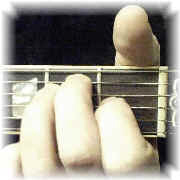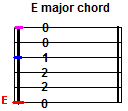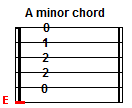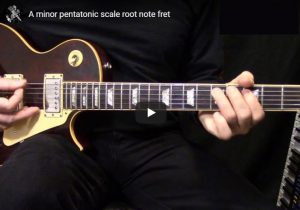
Welcome to Guitar Secrets
Guitar Lessons that work!
Guitar lesson 1 Guitar Lesson 2 Guitar Lesson 3 Guitar Lesson 4 Guitar Lesson 5
[ Sharps and flats ] [ Guitar Exercises ] [ Picking Exercise ] [ Guitar Tablature ] [ Guitar Tuning ]
Guitar tablature instruction. Learn how to read guitar tablature
Guitar tab is used in place of music notation
This guitar lesson explains how to read and use guitar tablature. Guitar tablature is a six line staff that represents the guitar fretboard. When reading tablature, numbers indicate which fret you play. Each line represents each of the six guitar strings.
The image below shows 6 lines. Each line represents the strings on the guitar. The letters to the left of the image below represent the strings of Low E, A, D, G, B and e. The Low E string would represent the Fat E string. Look below and find those 6 strings and memorize each of them.
The video below walks you through this lesson and in a little more in depth.
Click here to watch a video explaining how to learn guitar tablature.
In the illustration below, the 2nd fret of the G string is being played. The number 2 shown in the image above represents the 2nd fret, on the G string. Find and fret that 2 note on your guitar and pick it. When you pick the 2 or 2nd fret on G string, you are playing the A note.
When you read guitar tablature, the lines represent each string on the guitar. Look below and notice each guitar string and placement. There's a red line on the Low E string, this is the fattest string on the guitar. You do not have to use your middle finger to play the note, you can use your index finger if you like. Play that A note, 2nd fret of the G string.
Once again, each line in tablature represents each of the guitar strings. The numbers on each line or string represents the fret number you play. So, the number 2 on the G string means you play the note at the 2nd fret G string. This would be the A note.
The next illustration below, shows a 12 on the high E string and a 12 on the B string. Both of these notes are played together at the 12th fret, e and B string. Play those two notes at the 12th fret with your 1 finger.
The illustration below shows the E major chord. The notes that make up the E major chord are E, G# and B.
Look below and notice how the E chord would be displayed in tablature. Since all the notes illustrated below are lined up on top of each other, they would be strummed or played together.
The 0's are left open and strummed open along with the fretted notes. Compare the guitar fingering above to the guitar tablature below. You would use the fingering pattern above to to play the E major chord. You would finger all those notes and strum all six strings to play the E major chord.
The illustration below shows the fingering pattern for the E major guitar chord. Each number represents the finger you use to fret the note. The 0's are left open and strummed along with the fretted notes. Use the suggested fingering pattern below and strum the chord.
While you fret the E chord below, pick each note and see if you are fretting the chord cleanly. You want each note of the chord to ring out and not be muted. Hold the guitar straight and press down each note firmly. This is one of the hardest things to learn when you're first starting to play the guitar. Don't get discouraged if you have a little difficulty, it will get easier the more you practice.
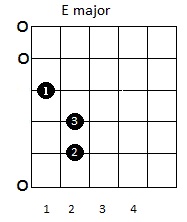
Once again, each finger has been assigned a number, you really need to make this second nature.
1 = Index finger
2 = Middle finger
3 = Ring finger
4= Pinkie
Look below and notice what the A minor chord would look like when written in guitar tablature. The notes of the A minor chord are A, C and E. When you finger or play the A minor chord, you are strumming all the notes illustrated on each line below.
The open A minor chord fingering pattern has been illustrated below. Notice there's an open A string and open high E string. You would strum those two open strings along with the fretted notes. Use this suggested fingering pattern to play the A minor chord. As you play the chord, make sure each note is played cleanly.

The next Illustration below, is that famous A minor pentatonic scale again. This time it is shown in tablature and also in the Root Note Position at the 5th Fret. The root note fret position is of the pentatonic scale rocks. In this position, you can play all the notes of the scale with your 1 finger never leaving the 5th fret position. This has been explained more in the pentatonic scale lesson.
In the last lesson, I had you working on the A minor pentatonic scale with the fingers highlighted. This time, in the image below, the frets are numbered on each string. I stated earlier that it is important to learn the fingering pattern system.
1 Index
2 Middle
3 Ring
4 Pinkie
The reason why it's so important to learn the numbering system is that eventually we will only be showing the numbers representing the frets on the strings and not the fingers to play each note of the scale. You will eventually have the fingering for each scale memorized and note even think about it.
Look at the image below and notice how it starts on the Low E string, 5th fret. The index finger is playing the note on the Low E string, at the 5th fret. This first note would be the first 5 or 5th fret below.

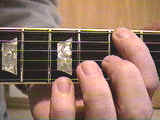

In the image above, the numbers below the strings, are the fingers that play the notes through the pentatonic scale. Look below and notice the number that represents each finger. The scale above, is the same scale as below. The image above is shown in tablature. The numbers below, represent the fingers to play each note of the scale.
1 Index
2 Middle
3 Ring
4 Pinkie
The A minor pentatonic scale has been illustrated below. The notes of this scale are: A, C, D, E and G.
The fingering pattern to play the A minor pentatonic scale at the 5th fret position has been illustrated below.
The fingers used to play the pentatonic scale above are: 1-4, 1-3, 1-3, 1-3, 1-4, 1-4.
The video below shows how to use the 5th fret position of the A minor pentatonic scale.
Watch a Video playing this scale
Here’s an example using the Am pentatonic root note fret position. Notice how the lead guitar part starts on the A note, 7th fret, play this over the Am chord. The numbers under the lead, are the suggested fingering.
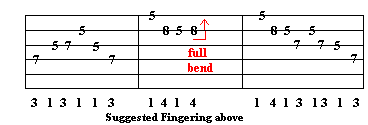
- We still need to practice some guitar fingering exercises and understanding guitar tablature will make playing the exercises that much easier. Don't worry if you don't have the A minor pentatonic scale in the root note position memorized, we will be working on it again.
- You should practice this progression in A minor. See if you can learn it without a video and just use the guitar tablature. It's always a good idea to learn how to play by ear. Sure it's easy to use the tablature, but don't let it become a crutch.
Save
Good luck,
Guitar Secrets





